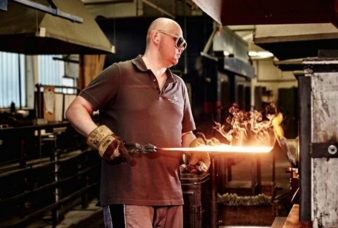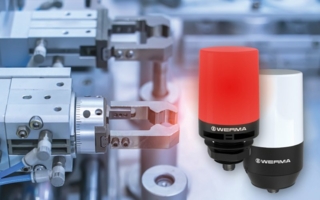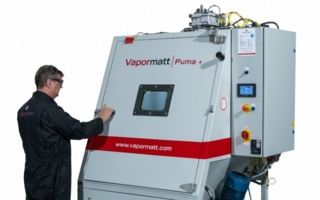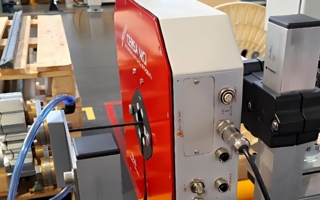03/08/2019
Forming without changing mechanical properties
A new process makes it possible to process round rods based on tungsten with a 63% degree of deformation. The result is lengths up to 720mm instead of the previous maximum of 320mm at a diameter of 10.5mm. The loss of material due to the machining finish is reduced to a quarter.
In the production of German Gesellschaft fuer Wolfram Industrie so far, approximately 26% up to 40% of the sintered material was removed by cutting for the production of round rods. The proportion of waste increased at low diameters and led to a significantly increased consumption of raw materials. As part of a research project, from 2016 to 2018, the company developed a non-cutting production process for the production of tungsten-based heavy metal round rods. It reduces material consumption through its iterative rotary swaging annealing process. At the same time, the mechanical properties of the alloy are retained, and thanks to the close-to-net shaping, material waste is reduced to an average of 8% to 10%. In addition, a doubling of the workpiece length from previously 370mm to up to 720mm even with a diameter of 10.5mm is possible in this way. The project was funded by the Central Innovation Programme for SMEs and the Federal Ministry for Economic Affairs and Energy, Germany.
Wolfram Industrie’s round rods are primarily made from a tungsten-based heavy metal alloy: Triamet G17. In these composites, tungsten precipitates are embedded in a Ni-Fe-W matrix, giving them a whole host of unique mechanical properties such as high density, tensile strength, and ductility. “The powder is mixed during the manufacturing process and pressed under high pressure into green compacts,” explains Wolfgang Jung, responsible metal expert for research and development at the Gesellschaft fuer Wolfram Industrie mbH. “However, with the previous production process, the last step in the CNC machining process lost about 20% to 30% of the material. These metal chips could no longer be used and had to be disposed of with great effort.” Therefore, Wolfram Industrie developed an iterative rotary swaging process with near-net shape shaping to enable more sustainable and economical production.
Identification of the essential process parameters
At the beginning of the research project, the project objectives were agreed on the basis of the international standard ASTM B 777-15 and the company’s own product standards for Triamet and summarised in a specification. This served as the basis for the procedure during the analysis and development of the forming process. “Previous attempts in this direction have shown that during the forming process of the heavy metal, the grain structure is stretched out and thus the mechanical properties are changed,” says Jung. “Unwanted consequences are an increase in the strength and hardness of the deformed heavy metal alloys – the required properties are no longer achieved.” Therefore, the enterprise sought to find ways to reduce the hardness of the deformed material, but at the same time increase the elongation at break, through targeted experimental design.
In the course of these experiments, Wolfram Industrie evaluated an optimal forming temperature for the forming process and also the degrees of forming were optimised with regard to crack formation. “This enabled us to minimise the change in mechanical properties through a specially developed thermo-mechanical forming process,” explains Jung.
Iterative rotary swaging annealing
Based on the results so far, Wolfram Industrie has developed a rotary swaging process with maximum degree of deformation and analysed the resulting grain structure and mechanical properties. “We realised that achieving the original material characteristics with a single thermal after treatment would be technically extremely complex and economically unviable,” says Jung. “Therefore, the idea of an iterative overall process emerged as a more economical alternative. Through targeted and repeated heat treatment, we were able to almost completely restore the original structure and mechanical properties of the material, regardless of the degree of deformation.”
Then the scoring was minimised and the post-processing effort and the process duration optimised. “In order to grind and process the material better, the rods should be as straight as possible,” explains Jung. “For this, we used new jaw geometry in our flat-hammering process, which not only made it possible to better align the rods in this process step, but also to reduce the processing time.” In this way, Wolfram Industrie achieved an average raw material saving of 18% to 32% depending on the geometry of the workpiece.
Applications for tungsten-based round rods
The new rotary swaging process from Wolfram Industrie can be used in practice for various areas. One such area of application for the tungsten-based heavy-metal rods is tool holders for high-precision manufacturing. When CNC machining, often large vibrations occur that can be transmitted to the mountings. However, Triamet has a high modulus of elasticity, which enables vibration-dampening. The longer design of the rods also allows more efficient processing with less waste in many previous applications. “Surely there are other uses for our long rods, which we have not thought of before,” says Jung. “Therefore, we are particularly looking forward to the dialogue with users and to new impulses for our further research work.”
Originally founded in 1911 as Wolfram Drahtfabrik GmbH for the production and processing of tungsten and molybdenum by the great-grandfather of today’s managing partner Marion Freifrau von Cetto in Berlin, the company was renamed to Gesellschaft fuer Wolfram Industrie mbH in 1928. The company’s headquarters were moved to Traunstein in 1943, where additional production buildings were constructed in the 1950s. After the death of the shareholder Helga Freifrau von Cetto, her daughter Marion Freifrau von Cetto took over management of the company as the owner in 1974. In 1991, the Gesellschaft fuer Wolfram Industrie mbH acquired the competitor Bayerische Metallwerke GmbH in Dachau that had been active in the market since 1926, thereby expanding its product range. Both companies produce exclusively in Germany. There are currently 57 employees at the Dachau location and 63 in Traunstein. In August 2018, the company opened another location in Winterthur, Switzerland, with Wolfram Industrie mbH.
Gesellschaft fuer Wolfram Industrie mbH
Permanederstrasse 34
83278 Traunstein
Contact person is Mr. Wolfgang Jung
Tel.: +49 861 9879-0
Bayerische Metallwerke GmbH
Leitenweg 5
85221 Dachau/Germany
Tel.: +49 8131 703-0





